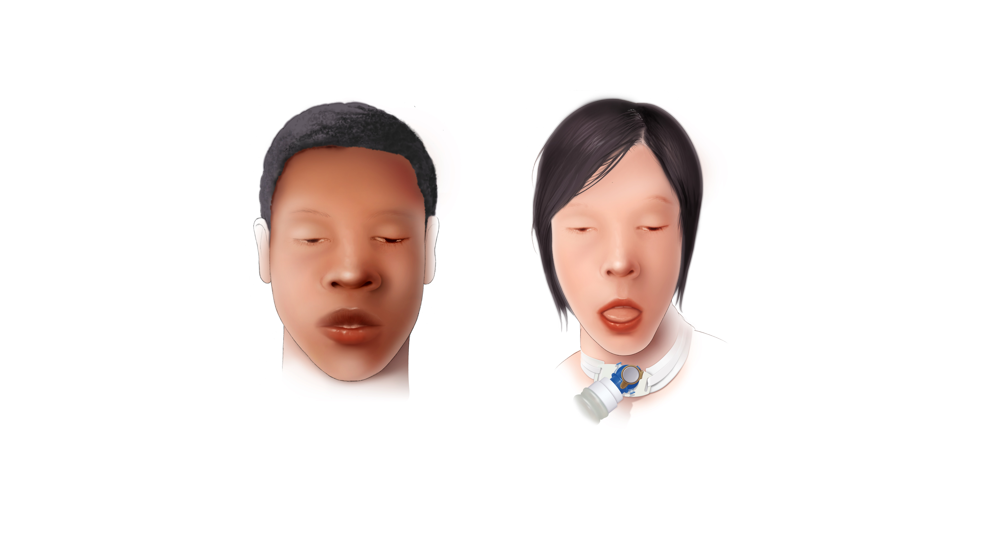Key points
- Initial diagnosis of botulism is based on clinical symptoms.
- Consultation is available for suspected cases.
- If clinical consultation supports botulism, begin treatment as soon as possible. Do not wait for laboratory confirmation.
- Botulism is a notifiable disease. All suspected cases must be reported to the state public health department.
Clinical features

Botulism is a neuroparalytic illness characterized by symmetric, descending flaccid paralysis of motor and autonomic nerves, always beginning with the cranial nerves.
Signs and symptoms may include:
- Dysphagia
- Muscle weakness
- Diplopia
- Ptosis
- Blurry vision
- Slurred speech
- Respiratory distress or failure
- Ocular palsy
Possible signs and symptoms in foodborne botulism may also include:
- Vomiting
- Nausea
- Abdominal pain
- Diarrhea
Signs and symptoms in an infant may include:
- Constipation
- Poor feeding
- Ptosis
- Sluggish pupils
- Flattened facial expression
- Diminished suck and gag reflexes
- Weak and altered cry
- Respiratory distress or failure
If untreated, illness from any type of botulism can progress to descending paralysis of respiratory muscles, arms, and legs.
Diagnosis
Botulism differs from other flaccid paralyses in that it typically manifests initially with prominent cranial nerve palsies. It also differs in its:
- Invariable descending progression
- Symmetry
- Absence of sensory nerve dysfunction
Botulism is frequently misdiagnosed, most often as a polyradiculoneuropathy (Guillain-Barré or Miller-Fisher syndrome), myasthenia gravis, or other diseases of the central nervous system.
Differential diagnoses
|
|
|
Routine laboratory test results are usually unremarkable for people with botulism. A normal Tensilon test helps to differentiate botulism from myasthenia gravis; borderline positive tests can occur in botulism. A normal CT or MRI helps to rule out cerebrovascular accident.
Treatment and recovery
Botulism case consultation
If you suspect your patient has botulism, immediately call your state public health department for expert clinical consultation and, if indicated, antitoxin release. Find your health department's after-hours number.
If the health department does not answer, immediately call:
Non-infant cases
- CDC's Clinical Botulism Service
- 770-488-7100 (24/7)
Treatment
Antitoxin
If clinical consultation supports botulism, request antitoxin immediately and begin treatment as soon as possible. Do not wait for laboratory confirmation.
Botulism Antitoxin Heptavalent and BabyBIG do not reverse paralysis but arrest its progression by neutralizing toxin circulating in the blood. Treating patients with botulism antitoxin early in the course of disease can prevent the progression of paralysis and consequent complications.
Intensive care and mechanical ventilation
Exercise meticulous intensive care, including monitoring of respiratory function and, when required, mechanical ventilation. In more severe cases, ventilator support may be required for weeks to months.
Provide meticulous attention to bladder and bowel care and the prevention of complications, such as urinary tract infections, DVT, and pressure ulcers. Evaluate for and treat dry eyes and dry mouth; anticipate the possibility of copious oral secretions.
Wound debridement
Treatment for wound botulism may also include wound debridement to remove the source of toxin-producing bacteria and antibiotic therapy.
Psychosocial support
Keep in mind patients with botulism are typically cognitively intact. Establish a system to enable communication between the patient and healthcare providers. Explain procedures before performing them.
Assess patients for anxiety and depression and provide psychological support as needed. Consider music and massage therapy and asking family or staff to read aloud to the patient.
Educate family members about botulism, and provide information about supportive care, treatment, and prognosis. Discuss psychosocial support resources available to family members, and consider starting a support group if multiple patients are hospitalized.
Recovery
Recovery follows the regeneration of new neuromuscular connections. This process takes weeks to months, even after antitoxin administration.
Have patients start speech, physical, and occupational therapy as soon as possible.
Diagnostic testing
Laboratory confirmation is done by demonstrating the presence of botulinum toxin in serum, stool, or food. Botulism can also be confirmed by culturing botulinum neurotoxin-producing species of Clostridium (C. botulinum, C. butyricum, or C. baratii) from stool or a wound.
Diagnostic testing is done through your state public health department laboratory. CDC provides testing services for some state public health departments.
This specialized testing often takes days to complete. Follow up with your state health department if you do not receive results within five days.
Sequelae
Death can result from respiratory failure or the consequences of extended paralysis. About 5% of patients die.
Those who survive may have fatigue and shortness of breath for years.
Notification and reporting
Botulism is a notifiable disease in the United States. Physicians must promptly notify the state health department of suspected cases. Laboratories must notify the state health department of all confirmed cases.
State health departments report confirmed cases to CDC through the National Notifiable Diseases Surveillance System.
Resources
CDC has resources for clinicians, including:
- Best practices for diagnosing, monitoring, and treating botulism, including during outbreaks
- Special considerations for certain groups of people
- Recommendations for medical and psychosocial supportive care
- Video guidance on preparing and administering antitoxin
